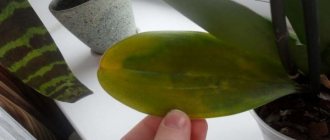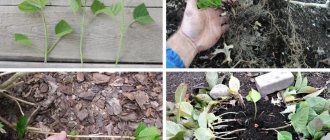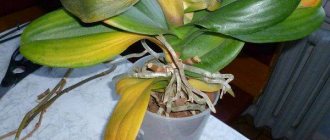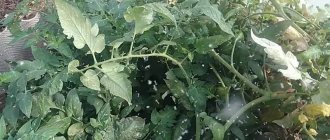What to do?
If the crop shows signs of fusarium wilt or a viral disease, then most likely it is impossible to save the plant. But trying to save culture is required in any case.
First, it’s worth determining the reason for the wilting of the plant’s foliage, it could be:
- overheating of roots due to sunlight, due to a heating battery;
- if you water the plant incorrectly, the substrate may become too wet or it has been dry for a long time;
- too much fertilizing leads to withering of the crop;
- caked, greasy substrate;
- incorrectly selected pot size;
- the appearance of pests;
- viral and fungal diseases.
{reklama}If spots appear on the foliage, any stains, pimples, or darkening are the result of an attack by pests or viral and fungal diseases.
Flowers fade for the following reasons:
- incorrect lighting;
- due to drafts;
- in the process of natural aging;
- due to the presence of food near food (for example, apples emit ethylene gas);
- orchids are too close to other plants.
You need to take out the orchid and carefully examine the roots.
You can understand that rot has appeared on the roots if:
- the rhizome has darkened;
- there are wet, oily, slimy places on the roots;
- they have become loose; when you press on the roots, liquid appears;
- they have become thinner, like threads;
- changed color from white, silver, greenish to brown or black.
Dry roots are easy to identify; this can happen due to improper watering or improper fertilizing.
Dry and rotten roots should be cut off with a sharp knife. It must be disinfected. The cut areas are sprinkled with crushed activated carbon and cinnamon powder. Then the roots are dried.
Attention! Trim the roots to healthy tissue.
If mold is visible on the substrate, it may be:
- due to increased humidity;
- due to insufficient light;
- lack of oxygen circulation in the substrate;
- old soil mixture;
- overly compacted or salty soil for orchids.
You can understand that the orchid was attacked by insects if:
- there are tubercles and spots on the foliage;
- leaves curl.
And lethargy, loss of foliage turgor, curling, falling of leaves and buds indicate that the roots are not in order.
Caring for an orchid after “revival”
Caring for the orchid after “revival” is very important. It guarantees that the plant will fully recover and will soon delight you with the appearance of flowers. The rules are simple. It is enough to follow these recommendations:
- You need to water the plant very carefully. It is advisable to use the method of irrigating the top layer of the substrate or pour water (a little) into the pan and place the pot with the plant in it for 20-25 minutes.
- It is better to refrain from feeding for at least one month after “revival”, so that the flower does not react negatively to the fertilizer. Next, you can introduce fertilizing in small quantities. If you notice darkening of the roots, wilting of flowers or dulling of leaves, stop using fertilizer immediately. Such symptoms indicate poisoning or burns of the root system.
- During watering, you can monitor whether there are pests on the plant. When the root system is moistened, they will crawl up the stem. If they are detected, you need to change the substrate in the pot and treat the roots of the plant with a fungicide.
- The health of an orchid depends on the quality of the substrate. Use only good and not too dense soil so that the plant feels comfortable and problems are eliminated in the future.
- Maintaining comfortable conditions: temperature in the range from 22 to 25 degrees, humidity at 30%-40%, lighting for at least 10-12 hours every day.
- Inspect the plant regularly to prevent diseases, pests, rot and other problems.
Remember! Neither fertilizers nor growth preparations should be used during the recovery period of the orchid after damage. This can lead to the root system of the flower being poisoned.
How to revive a dying orchid?
Dying orchid
If the roots are damaged just a little, then you can dip them in a fungicide solution (Bordeaux mixture), then dry them and transplant the plant into another container with a new substrate.
If some roots have rotted, then you need to trim them back to healthy tissue. Then sprinkle the cuttings with coal and plant them in another pot with a new soil mixture.
If the roots are completely rotten, then it is worth cutting off all the roots and clearing the core of the stem to healthy tissue. Treat with an antiseptic (solution of brilliant green, iodine), dry. Sprinkle with Kornevin. Place the plant above a container of water so that the water does not reach the roots by 1.5-2 cm.
You can also use the Aksenova method.
Place a layer of expanded clay on the bottom of the container, then sphagnum moss and chopped bark. Water is poured so that it covers the expanded clay. And the trimmed plant is placed on top of the bark. All this is placed in a plastic bag or aquarium.
If the roots are damaged, the plant cannot be fertilized. Watering should be reduced. Place the orchid on a bright windowsill.
Orchid left without roots
What to do if the orchid has dried out or rotted and is left without roots? This question arises for those gardeners whose plant has lost almost its entire root system. Even in this case, there is a chance to restore the plant with proper care and patience. There are three main methods of revival:
- Using a greenhouse.
- Through regular watering and drying.
- Using an ordinary substrate.
It is very important to choose the most effective method. First you need to assess the condition of the plant. The duration of rehabilitation depends on this. On average, a flower that has lost up to 60% of its root system will need at least one month to recover. But a plant that, for any reason, has lost 90% or more of its roots will recover within eight to twelve months. In any case, it is very important to ensure proper maintenance and care.
So, what to look for when choosing a method to save an orchid? Consider the condition of the affected color, the number and condition of the remaining leaves, the presence of root primordia formed in the lower part of the leaf rosette (without this growth point, resuscitation will be more problematic). It is also worth paying attention to the conditions that the grower can provide for the orchid during the period of resuscitation.
Reanimation of a flower in greenhouse conditions
Resuscitating a flower in greenhouse conditions is considered the simplest and most effective. A florist will need a windowed greenhouse where he can achieve comfortable temperatures and high humidity on a constant basis.
In principle, the procedure for resuscitating a plant is simple:
- You need to take a container in which the flower will be rooted, and first pour a thin layer of expanded clay into it, and then cleaned sphagnum moss (it is advisable to steam it first).
- Then you should place the root rosette in the prepared container and install it in the greenhouse.
Note! In the greenhouse, it is necessary to maintain humidity in the range of 70%-100%, temperature from 22 to 28 degrees (temperatures below 20 and above 33 degrees will lead to the fact that root growth will be suspended, and the proliferation of fungi and pathogenic flora will occur quickly), bright and diffused lighting for 12-14 hours a day on an ongoing basis until the flower has formed roots at least 3-5 centimeters long.
This method is suitable even in cases where all the roots of the orchid have rotted. Monitor the condition of the plant after carrying out the above-described manipulations. If necessary, the greenhouse must be ventilated and the substrate moistened. It is advisable to do this at night. The purpose of the procedure is to saturate the air with carbon dioxide and accelerate the formation of the rudiments of a new root system of flowers.
The success of the procedure depends on many factors, including maintaining the required conditions. At the same time, regularly inspect the plant to get rid of pockets of rot when they first appear.
With proper care, the first roots will appear after 10-14 days. You can transfer the orchid to its usual conditions (plant it in a pot with a substrate and remove it from the greenhouse) no earlier than roots 3-4 centimeters long have formed.
Resuscitation using watering and drying
Resuscitating a house with the help of watering and drying is quite possible. This method is suitable for those gardeners who do not have a greenhouse. You will need a deep glass vessel into which you need to place a pre-treated (trimmed from rotten roots and with treated cut areas) leaf rosette. Every day you need to pour water into the container (necessarily soft, filtered or boiled), and so that the outlet only touches the water, and the leaves remain unaffected.
The plant is left in this form for six hours. Then the water is drained and the flower is left to dry until the next morning. Then the procedure is repeated.
Advice! You can make sweet or honey water for faster formation of new roots. To do this, you need to dilute one teaspoon of honey or one tablespoon of sugar in one liter of water.
Additionally, it is useful to use the following tools:
- complex fertilizers, but they should be used in low concentration;
- preparations with a high iron content for feeding;
- growth regulators for monthly treatment.
Revitalizing an orchid by planting it in a substrate
Reviving an orchid by planting it in a substrate is an alternative method that can be used if the plant has not lost all its roots, but only part of them. A distinctive feature is the ability to feed the flower in the usual way. The missing roots can be grown by planting the plant in a pot.
The diameter of the container should be about 6-8 centimeters. You can use an ordinary substrate in which all orchids grow. But it must be fresh. It is imperative to maintain the temperature in the range of 22-25 degrees and lighting for at least 12 hours a day. In this case, it will be possible to activate root growth. Remember that even at night you cannot reduce either the temperature or the humidity (it can even be increased a little) so as not to slow down the formation of the root system.
The plant cannot be watered; it can be irrigated, and only the top layer of the substrate. You can also place the orchid pot in a tray with a small amount of water. The next moistening of the soil is carried out after complete drying. New roots will begin to appear 2-4 weeks after resuscitation begins.
Temperature violation
In summer, the plant requires the air temperature in the room to be +22-25 degrees, and in winter +18-20 degrees.
If the air temperature is too high, the orchid must be placed in the shade, without feeding or watering. After 3-4 hours, lightly spray the plant with water. Then move it to a safe place.
If the air temperature is too low, the orchid is placed in a warmer place. Do not water or feed for some time. Wait until the plant adapts.
When attacked by pests, the plant is treated with Fitoverm.
Why does an orchid die?
The main reasons for the death of the culture are the inconsistency of the conditions of detention with the requirements. Significant temperature changes, waterlogging of the substrate, and critical lack of lighting can be detrimental to it.
Most often, problems arise during the cold season. The flower reacts negatively to the following factors:
- dry air during heating operation;
- cold coming from the glass when kept on the window;
- watering with hard water;
- overheating or burns when exposed to sunlight;
- constantly wet substrate combined with low temperature;
- excess or improper application of fertilizers;
- violation of root aeration due to too compacted substrate;
- infection by insect pests or fungal diseases.
If the necessary conditions are not created and the factors affecting the well-being of the flower are not eliminated, it will soon begin to die.
Signs that a plant needs to be revived
First you need to understand when the plant withers and dies, and when the natural process of changing leaves occurs. With natural wilting, only the lower leaves are affected, and new ones grow to replace them. But the following signs are indicators of the unfavorable state of the plant:
- The leaves are covered with strange spots.
- The leaves turn yellow, curl and fall off.
- The roots have either dried out or turned brown.
- Rot is visible in the orchid rosette and on the stem.
Resuscitation methods
There are many options for restoring a dying orchid. It is worth considering the most popular of them.
Mini greenhouse, aquarium
This method will require a transparent structure, regular ventilation, and a warm place. In this case, you need to know that the substrate is not watered, but slightly moistened.
Sphagnum moss
The qualities of moss are important for the restoration of phalaenopsis. It quite successfully absorbs moisture, is breathable and has bactericidal properties, which is necessary for the resuscitation of the plant.
Hydrogel
Experienced gardeners do not recommend using hydrogel for orchids, but in rare cases such procedures can be carried out.
Styrofoam
Polystyrene foam does not have any healing properties. It is used solely for stability.
Expanded clay, vermiculite
The materials are used as an aid if bark or sphagnum is not available. They successfully replace drainage.
Hot shower
An extremely dangerous way to restore a flower. If possible, it is better to use another method that is more suitable.
Why orchid leaves can become limp and soft, the main problems associated with care
The first thing that reacts to human mistakes in care is the leaves, which become soft and limp. The health of the entire plant is judged by the condition of the leaves.
Orchid leaves have become soft due to lack of watering
In overdried soil, an orchid may not only become limp and soft leaves, it may even die. However, there is no single watering schedule for this tropical crop - each specimen is unique. Therefore, before watering, it is necessary to assess the condition of the soil in the flower pot. The soil should always be slightly moist and loose.
What to do?
Immediately place the orchid and the pot in warm water for 30 minutes.
Then water as the top layer of soil dries, but not more than once a week, avoiding excess moisture.
The orchid was transfused
Leaves may become soft and limp due to excessive watering and stagnation of water in the tray of the pot. Excess moisture causes root rot. Weakened roots cannot provide adequate nutrition, the leaf plates become soft and lethargic.
What to do?
You need to check for holes for water drainage in the bottom of the flower pot. You cannot fill the orchid with water so that the container underneath is always dry. The room must be ventilated frequently.
Excess sun and overheating in orchids
The orchid is a tropical crop and loves sunlight and warmth. However, direct sunlight in hot summers, especially in the afternoon, causes great harm to it.
When there is too much sun, it is difficult to maintain optimal humidity levels. The air becomes dry, and the soil in the pot dries out - it becomes hot. In this case, the roots of the plant will lack moisture.
Another sign of overheating is that the leaves have wrinkled, become limp, soft, and drops of water are released from them. As a result, the leaf blades and peduncle will not be able to receive the necessary nutrients. Outwardly, it looks like soft and limp leaves.
What to do?
The orchid is immediately transferred to the shade and sprayed. It is very important that water does not get on the inflorescences. If you do not help the orchid in time, it will soon die. You need to closely monitor the temperature in the summer.
In winter, the roots may overheat due to heating radiators. The roots lack moisture, so the leaves become soft and limp.
ON A NOTE! A good way to help is to replant it in a double pot. The inner pot should have holes to drain excess moisture, but the outer one should not. Pebbles or expanded clay are poured into an airtight pot and a second container with a flower is inserted. Thus, after watering, water will go to the stones and evaporate. Thanks to this simple device, the roots will be moistened and will not be in danger of overheating.
Hypothermia of a flower
In winter, the pot must be positioned in such a way that cold air from the street does not reach it. A sharp drop in air temperature leads to hypothermia. Flowering stops, buds and flowers fall off, and leaves wrinkle, become soft and limp.
What to do?
Take care of the microclimate: make the room temperature comfortable and normalize the humidity level.
Orchid planted in the wrong soil
If poor-quality soil is used for planting, it becomes very compacted over time. This means that watering causes the soil to sink, and salt deposits, fungus and even mold may appear in it.
In such conditions, oxygen poorly reaches the roots of the plant, and its above-ground parts suffer. Do not clog the soil with peat and moss.
What to do?
Regularly replant and change the soil. During transplantation, all damaged tissues and processes must be removed, and the cut sites must be treated with antiseptics.
The soil is pre-disinfected with special preparations.
The products “Alirin” and “Maxim” will help to root the orchid better.
ATTENTION! It is necessary to use only high-quality substrate intended for this indoor culture.
Excessive feeding of an orchid
Flowers need moderate fertilization regularly once a month - approximately every third watering. During the flowering period, you can feed twice a month.
ON A NOTE! You need to carefully study the composition of fertilizers. For example, nitrogen activates leaf growth, but can have a bad effect on turgor pressure, making them sluggish and soft. Complex fertilizers that contain phosphorus, potassium and sodium humate are suitable for feeding orchids.
What to do?
Fertilize no more than twice a month with special preparations, for example: Bona Forte, Florovit, Agricola.
Incorrect transplant
Orchid wilting after transplantation is a common problem. However, if it continues to wither and the leaf plates become increasingly soft, this means that mistakes were made during the movement:
- the soil is chosen incorrectly;
- the acid-base balance of the soil is disturbed;
- There are no holes in the pot to drain excess moisture.
What to do?
The flower should only be replanted in a special pot with proper drainage, and the soil should be loose and consist mainly of small fractions of bark.
What to do if the plant is flooded?
Excessive moistening of the substrate is the main mistake of novice gardeners. The roots of an orchid are special, and you cannot water it like other crops. You can tell that a plant is flooded by the color of the roots in the pot. Then the leaves begin to wrinkle and the buds fall off. If measures are not taken, the flower will soon begin to die.
Important! Most often, overflow occurs if, when immersing a pot in a container of water, they forget to remove it in time. A substrate overflowing with moisture is detrimental to an orchid.
Eliminating flooding and overflow
The only way to cope with flooding or overflowing is to transplant the flower into a fresh substrate and replace the pot. Operating procedure:
- The plant is carefully removed from the pot. It cannot be pulled out, otherwise the roots will break. It is better to carefully cut the pot into two parts and remove them.
- The substrate is cleaned from the roots, washed with warm water and inspected.
- Use sharp, disinfected scissors to cut off the rotten parts.
- After drying, the sections are powdered with crushed charcoal or cinnamon.
- Spray the roots with fungicide and leave the rosette to dry for a day.
- Drainage is placed at the bottom of the new pot, freshly prepared substrate is poured in a thin layer and the orchid is placed on it. The free space between the roots is covered with substrate, leaving the root collar on the surface.
Carefully! Inexperienced gardeners try to dry a waterlogged substrate by heating it with a hair dryer. The hot air flow acts on the flower like a real hurricane. From such help he will not recover, but will definitely die!
How not to overwater an orchid?
The plant requires strictly controlled moistening of the substrate in different phases of development, at different temperature and humidity levels in the room. For an orchid, both overdrying and overmoistening are equally dangerous.
On average, the frequency of watering is as follows:
- during the active growing season - 2 times a week;
- during flowering and in very hot periods - every other day;
- during the rest period - once every 2-3 weeks.
When regulating moisture, it is also worth considering the type of orchid:
- Cymbidium, Phalaenopsis, Paphiopedilum are watered when perspiration disappears on the inside of the walls of the pot.
- Cattleya, Oncidium, Odontoglossum, Dendrobium require the substrate to dry completely before the next watering.
- Vanda needs daily spraying from a spray bottle.
Important! For irrigation, use exclusively soft, settled or filtered water at a temperature of 30-35 degrees.
Features of growing orchids
Several types of orchids are grown at home, and each of them has its own individual characteristics. However, for all plants it is necessary to create conditions as close as possible to natural ones.
Common features include:
- using plastic containers instead of clay ones;
- maintaining the temperature at +20°C (not lower);
- good lighting;
- sufficient moisture without stagnation of water.











